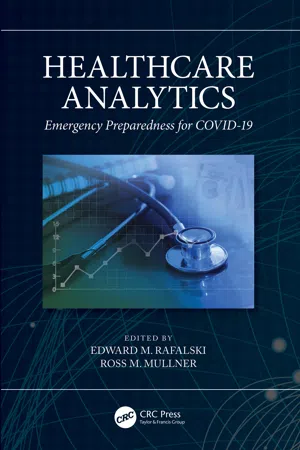
Healthcare Analytics
Emergency Preparedness for COVID-19
- 264 pages
- English
- ePUB (mobile friendly)
- Available on iOS & Android
Healthcare Analytics
Emergency Preparedness for COVID-19
About This Book
The first COVID-19 case in the US was reported on January 20, 2020. As the first cases were being reported in the US, Washington State became a reliable source not just for hospital bed demand based on incidence and community spread but also for modeling the impact of skilled nursing facilities and assisted living facilities on hospital bed demand. Various hospital bed demand modeling efforts began in earnest across the United States in university settings, private consulting and health systems. Nationally, the University of Washington Institute of Health Metrics and Evaluation seemed to gain a footing and was adopted as a source for many states for its ability to predict the epidemiological curve by state, including the peak.
This book therefore addresses a compelling need for documenting what has been learned by the academic and professional healthcare communities in healthcare analytics and disaster preparedness to this point in the pandemic. What is clear, at least from the US perspective, is that the healthcare system was unprepared and uncoordinated from an analytics perspective. Learning from this experience will only better prepare all healthcare systems and leaders for future crisis.
Both prospectively, from a modeling perspective and retrospectively from a root cause analysis perspective, analytics provide clarity and help explain causation and data relationships. A more structured approach to teaching healthcare analytics to students, using the pandemic and the rich dataset that has been developed, provides a ready-made case study from which to learn and inform disaster planning and preparedness. The pandemic has strained the healthcare and public health systems. Researchers and practitioners must learn from this crisis to better prepare our processes for future pandemics, at minimum. Finally, government officials and policy makers can use this data to decide how best to assist the healthcare and public health systems in crisis.
Frequently asked questions
Information
Table of contents
- Cover Page
- Half Title page
- Title Page
- Copyright Page
- Dedication
- Contents
- Foreword
- Contributors
- Introduction
- Chapter 1 What is an epidemic, a pandemic?
- Chapter 2 A brief history of pandemics
- Chapter 3 The healthcare continuum
- Chapter 4 The fog of war and data
- Chapter 5 Sources of data/modeling
- Chapter 6 Quantifying and responding to COVID’s financial and operational impact
- Chapter 7 Measuring and addressing healthcare employee well-being in an Alabama health system during COVID-19
- Chapter 8 Colorado state case study
- Chapter 9 Case study A Florida COVID-19 dashboard
- Chapter 10 State case study Illinois
- Chapter 11 Tennessee case study
- Chapter 12 Regional modeling
- Chapter 13 Healthcare analytics The effects of the pandemic on behavioral health
- Chapter 14 Digital transformation in healthcare How COVID-19 was an agent for rapid change
- Chapter 15 Telehealth
- Chapter 16 The COVID-19 pandemic and development of drugs and vaccinations
- Chapter 17 Value of health information exchanges to support public health reporting
- Conclusion
- Epilogue
- Index